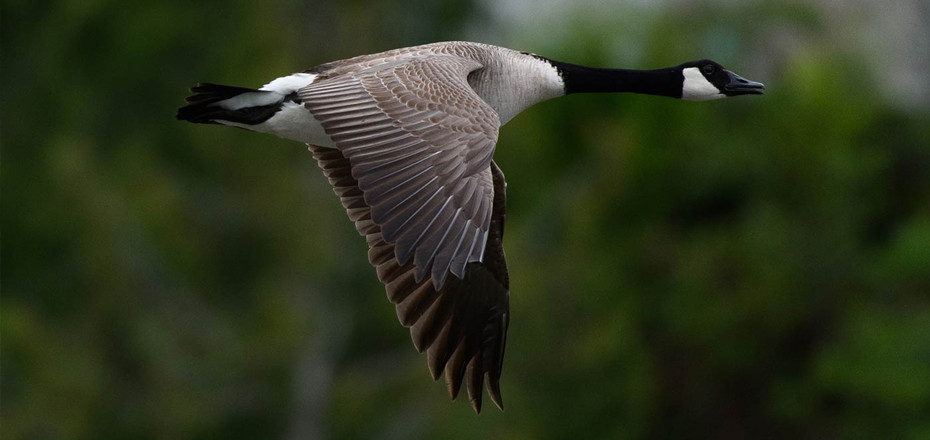Geese are a common sight across North America, whether gracefully gliding on a local pond or honking loudly in V-formation overhead. But have you ever wondered, “Do Geese Fly South For The Winter?” The answer is a resounding yes, for many species. These impressive birds undertake remarkable journeys each year to escape the harsh conditions of colder climates and find more favorable environments. Let’s delve into the fascinating world of geese migration and understand why and how these birds embark on their annual southward trips.
Understanding Geese Migration Behavior
Migration is a seasonal journey undertaken by many animal species, and for geese, it’s a crucial part of their life cycle. Across the United States and Canada, you’ll find over a dozen different species of geese, each with its own unique migration habits. Interestingly, some populations, like certain Canada Geese, have become less migratory, sometimes referred to as “resident geese.” These Canada Geese often remain within the US year-round and might not undertake long migrations to Canada, a shift from historical patterns. However, it’s important to note that the instinct to migrate remains strong in most geese species, driven by the need for survival and reproduction.
The Case of Canada Geese Migration
While some Canada Geese are becoming more sedentary, it’s not the case for all. Many Canada Geese still follow traditional migratory routes. These geese typically begin their southward journey between September and October. Their destinations are often warmer regions further south, where they spend the winter months before returning north between April and June. This migration can be quite extensive, with some Canada Geese flying as far north as the Arctic circle for breeding season.
What Exactly is Geese Migration?
Geese migration is a cyclical, annual pattern driven by seasonal changes. This journey is essential for geese to access vital resources like food, suitable shelter, safe nesting locations, and generally more comfortable living conditions. Geese are primarily herbivores, feeding on stems, roots, grasses, worms, berries, and other natural food sources. These resources become scarce in northern regions during the winter months.
Geese are exceptionally well-adapted for long-distance travel. They can fly remarkable distances in a single day, sometimes exceeding a thousand miles, depending on weather conditions. This ability allows them to efficiently travel from as far north as Canada to the southern reaches of the United States in a relatively short period. Geese are famous for migrating in flocks, often forming the iconic V-shaped formation that fills the skies during migration seasons, accompanied by their characteristic honking calls.
Where Do Geese Migrate To?
Geese migration is a significant wildlife event easily observed across much of North America, given the large population of over 3.5 million geese in the United States alone. Their large flocks, V formations, and loud honking make them hard to miss. The specific flight paths vary among different geese species. Some species undertake epic journeys from the far northern reaches of Canada to the southern United States and even into Mexico.
 Why Are They a Problem?
Why Are They a Problem?
Regardless of the exact route, the primary goal of geese migration is to find warmer climates for the winter. They seek out regions with milder temperatures and, crucially, bodies of water that remain unfrozen, providing both drinking water and refuge from predators.
The Driving Forces Behind Geese Migration
The primary reason geese fly south for the winter is to escape the freezing temperatures and harsh winter conditions of northern regions. They are in search of open water sources, like ponds, lakes, and coastal areas, that haven’t iced over. These warmer, ice-free environments provide access to food and reduce the energy expenditure needed to survive in freezing temperatures.
While geese generally return to the same overall migration areas annually, individual flocks can have slightly different migration patterns and preferred wintering locations. The timing of migration can also vary. Some geese may depart earlier, seemingly anticipating the onset of harsh weather, while others might wait until the cold weather truly forces them southward. Ultimately, migration is driven by a combination of factors: the need for safe, unfrozen water sources, readily available food supplies, and suitable locations for raising their young.
Molting Season and Its Influence
Molting, the process of shedding old feathers and growing new ones, is a critical part of a goose’s life cycle. It typically occurs once a year, after the breeding season, and significantly impacts their ability to fly. For about six weeks during the summer molting period, geese lose their flight feathers, rendering them flightless. During this vulnerable time, geese seek out habitats that offer both abundant resources and protection from predators. These safe havens are often bodies of water that provide refuge from land-based predators and allow them to escape into the water if threatened.
If you observe a sudden influx of geese at a local lake or pond during the summer, outside of the typical migration seasons, it’s likely due to molting. These geese are seeking temporary shelter and resources while they undergo this feather renewal process. If these locations are particularly favorable, geese may develop a preference for them and return in subsequent years.
Nesting Season and Migration
Geese nesting season occurs earlier in the year, generally starting around June, following their spring migration northward. After arriving at their breeding grounds and establishing suitable nesting locations, geese begin the process of laying and incubating eggs. With millions of Canada geese alone in North America, a vast number of geese are seeking safe nesting spots to protect their eggs from predators and environmental hazards.
Once geese find a nesting area they favor – be it a pond, park, or nature center – they often exhibit strong site fidelity, returning to the same location year after year for breeding and nesting. Some geese have been known to return to the same nesting sites for over a decade, making it a deeply ingrained part of their annual cycle. This strong attachment to nesting sites highlights the importance of habitat conservation and responsible management of geese populations, especially in areas where they may be perceived as a nuisance.
Why Geese Return to the Same Places Year After Year
Geese exhibit remarkable fidelity to both their wintering grounds and breeding locations. They consistently return to the same migration spots each winter, driven by the need for safe habitats that provide sufficient food for themselves and their offspring. As winter recedes, they undertake the long journey back to their northern breeding grounds, sometimes traveling thousands of miles.
This homing behavior is deeply ingrained. Geese are believed to navigate using a combination of methods, including the Earth’s magnetic field, the position of the sun and stars, and learned landmarks. While the exact mechanisms are still being researched, it’s clear that geese possess an impressive ability to remember and retrace their migratory routes. Some geese are known to return to their original nesting sites for up to 12 consecutive years.
Their intelligence and memory are also evident in anecdotal observations suggesting that geese can recognize individual humans they have encountered, even after extended periods. If geese establish themselves on a property, they are likely to return year after year, especially if they successfully breed and raise young there, as these patterns can be passed down through generations.
Deterring Geese from Your Property
If geese are becoming unwelcome residents on your property, there are humane methods to deter them. One key strategy is to remove access to food sources. This includes eliminating bird feeders and discouraging people from feeding geese directly.
Utilizing Trained Border Collies for Geese Control
Companies like Go Geese Go offer specialized geese control services using trained Border Collies. These dogs, through their natural herding instincts, create a perceived predator threat for geese. This method effectively discourages geese from settling in an area without causing them harm. Border Collies can be a highly effective and humane way to manage geese populations in various settings, from private properties to large commercial sites. For those seeking professional help in managing geese, exploring such services can provide a practical and environmentally conscious solution.
Go Geese Go: Experts in Humane Geese Management
Go Geese Go specializes in providing expert, humane geese control solutions. Their approach is rooted in understanding geese behavior and utilizing non-harmful methods to encourage geese to relocate. By combining expertise with practical, dog-based solutions, they offer a valuable service for those seeking to manage geese presence on their properties. For further information on geese control strategies and services, contacting professionals like Go Geese Go can provide tailored advice and effective solutions for specific geese management needs.

